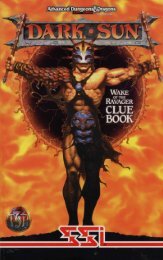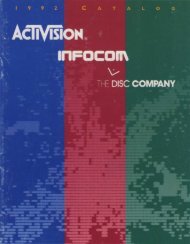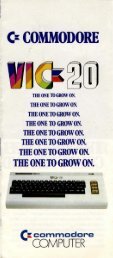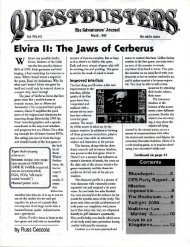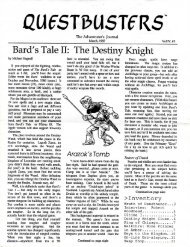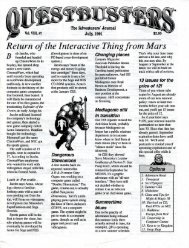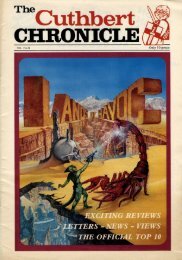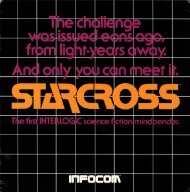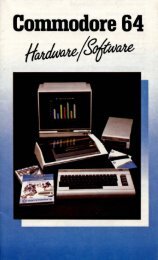QuestBusters - Museum of Computer Adventure Game History
QuestBusters - Museum of Computer Adventure Game History
QuestBusters - Museum of Computer Adventure Game History
You also want an ePaper? Increase the reach of your titles
YUMPU automatically turns print PDFs into web optimized ePapers that Google loves.
0<br />
Last month "Lord British" revealed<br />
details about the upcoming Ultima<br />
V. In the rest <strong>of</strong> the interview he<br />
discusses a range <strong>of</strong> other games<br />
Origin has under development.<br />
QB: What other new games has Origin<br />
got planned for this year?<br />
Garriott: Space Rogue, which Paul<br />
Neurath is writing, should be out by<br />
Christmas. It's a fantasy role-playing<br />
game (one-character, one ship) in which<br />
you travel through space with these 3-D<br />
graphics—Paul is actually a math major<br />
and is very good at algorithms and<br />
artificial intelligence—and his enemy<br />
spacecraft are not just dumb objects that<br />
point at you and attract. They actually<br />
have maneuvering capabilities and logical<br />
flight paths: You can follow them on<br />
these paths around ships and other<br />
objects, through asteroid fields, through<br />
star bases that are hollow in the center<br />
where you can land on the central pad—so<br />
you sincerely get the feeling you're flying<br />
around in space. Then when you land on<br />
a planet or starbase, it switches to a topview,<br />
tile-graphic mode so you can travel<br />
through the starbase and reprovision your<br />
craft, have it repaired, hire more crew and<br />
that sort <strong>of</strong> thing.<br />
QB: Like a combination <strong>of</strong> a flight<br />
simulator in space and role-playing?<br />
Garriott: Yes. We've all seen flight<br />
simulators and other kinds <strong>of</strong> flight<br />
games, we've even seen some space<br />
games. But most <strong>of</strong> them, especially<br />
space games, are done with line drawings,<br />
so they're not very technologically<br />
impressive in my opinion. Even those<br />
that are give you a kind <strong>of</strong> jerk-jerk-jerkjerk<br />
view <strong>of</strong> the world, and I find that<br />
disappointing and depressing, kind <strong>of</strong><br />
disturbing. Space Rogue has a distinct<br />
advantage in that it uses a 3-D graphics<br />
package that allows them to do polygon<br />
surfaces. Just for example, you could<br />
take a standard D & D 20-sided die and<br />
put that image on the screen, color all the<br />
surfaces and do full clipping on that entire<br />
object rotating and translating in all the<br />
dimensions in real time. No flicker, no<br />
jerking, ok? Additionally you can have<br />
up to sixteen or so <strong>of</strong> these polygons on<br />
the screen at the same time, all doing that<br />
same thing, all in real-time with no<br />
flicker or jerking, fully masked and in<br />
color. And even masking between<br />
4 <strong>QuestBusters</strong><br />
Richard Garriott<br />
X Interview, Part<br />
objects. That's the core <strong>of</strong> the reason<br />
Space Rogue is going to be such a<br />
success, because technologically this goes<br />
far beyond anything I've ever seen on an<br />
eight-bit computer.<br />
QB: What's the plot line?<br />
Garriott: People have just begun<br />
discovering a network <strong>of</strong> warp gates built<br />
long ago, which are actually portals to<br />
the farthest edges <strong>of</strong> the universe. And<br />
the people on the other end <strong>of</strong> these<br />
portals turn out to be rather hostile and<br />
are using the gates to slowly,<br />
methodically invade your territory. You<br />
can actually watch these craft come in<br />
from a distance and see them bombarding<br />
your bases and things. If you just fight<br />
them <strong>of</strong>f at home, you're fighting a<br />
losing battle because there's an infinite<br />
number <strong>of</strong> them. So the solution is to<br />
discover the use <strong>of</strong> the warp gates, find a<br />
path into their territory and eradicate the<br />
enemy on his on turf, so to speak. By<br />
following them as they come and go you<br />
can discover the warp gates.<br />
QB: It sounds like the kind <strong>of</strong> game I<br />
would like, since I really prefer the<br />
science fiction over the straight fantasy<br />
games.<br />
Garriott Yeah, it's something that is<br />
very appealing but technologically is just<br />
now reaching the stage where it can do<br />
well. With the capability <strong>of</strong> the graphics<br />
<strong>of</strong> Space Rogue, I can already envision a<br />
great deal more science fiction products<br />
coming out <strong>of</strong> that technology. And it's<br />
actually something we're already<br />
debating: What are we going to follow<br />
this game up with? Because it's really<br />
such a good idea, one that can be applied<br />
in a number <strong>of</strong> different fields.<br />
QB: Could it be used in an Ultima or<br />
another fantasy game?<br />
Garriott: Absolutely. If the first Space<br />
Rogue does well, which we fully expect<br />
it to do, we already have plans for sequels<br />
and development into a whole other genre<br />
<strong>of</strong> its own.<br />
QB: Any other new games in the near<br />
future?<br />
Garriott We've got 2400 AAD, which<br />
is Chuck Buche's project It's a kind <strong>of</strong><br />
1984ish future world in which the robots<br />
have been installed as the sentries and lawgivers.<br />
And essentially they have taken<br />
over and the people have become like<br />
sheep, herded around by the robots.<br />
You're the leader <strong>of</strong> a rebellion movement<br />
to retake the city from the robots. It's<br />
done in the Ultima style <strong>of</strong> presentation,<br />
with tile graphics and so on, but the<br />
visuals and types <strong>of</strong> interaction are<br />
futuristic. And these little robots move<br />
around as the non-player characters, and<br />
there are some other people, <strong>of</strong> course,<br />
but you have to be a little covert in your<br />
actions with them.<br />
And Mike Berlyn is doing our first text<br />
adventure, RAGER. It's about a<br />
supercomputer working on a subatomic<br />
particle problem, using a human as an<br />
interface to help it solve the problem.<br />
However, it turns out the artificial<br />
intelligence in the computer is<br />
schizophrenic, and when you tie in with<br />
it you get trapped in its world. Initially<br />
it looks real, but you discover the desks<br />
are made <strong>of</strong> cardboard, and a cabinet might<br />
be painted on a wall or obviously twodimensional.<br />
So you have to go around<br />
in that alter ego world and try to help the<br />
computer solve the problem—and escape,<br />
since that is also a problem.<br />
QB: Why did you decide to do an all-text<br />
game?<br />
Garriott: Because there are certain things<br />
you can do with text adventures that<br />
are impossible in a role-playing game.<br />
Normally we wouldn't do one—see, we're<br />
not interested in doing a regular text<br />
adventure. We're only interested in doing<br />
those that are state-<strong>of</strong>-the-art, that have<br />
other people or egos moving around in<br />
the game and interacting with you in a<br />
very realistic manner. And we figured<br />
that if anybody could do a good one it's<br />
Mike Berlyn, because <strong>of</strong> his track record<br />
<strong>of</strong> doing state-<strong>of</strong>-the-art stuff.<br />
We're also starting in on doing a multiplayer<br />
Ultima. James Van Artsdalen,<br />
who does our IBM and Macintosh<br />
translations, is working on a program<br />
that lets several people participate in the<br />
game. Two people can do this with<br />
different computers directly connected via<br />
modems, or even more can play via a<br />
system with multiple modems. We don't<br />
know if we'll be able to support packet<br />
networks like CompuServe because they<br />
may be top slow for this application.<br />
We'll do it if we can. What you'll buy in<br />
the store will be a package containing all<br />
the core graphic routines and the game<br />
development stuff (all the commands and<br />
so on), which you could even plug into<br />
your computer and play as a stand-alone.<br />
But with a modem you could tie a friend<br />
into the game, or up to somewhere<br />
between eight and sixteen other players,<br />
all within the same game.<br />
QB: This would be best for people in<br />
the same city, then?<br />
Continued on page eight



